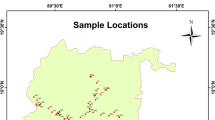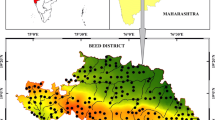Abstract
This study has been carried out to determine the uranium concentration associated with physicochemical parameters and water quality index during pre-monsoon and post-monsoon of Bemetara district to correlate the quality of water for public health. The correlation matrix has been applied for the determination of the correlation value to find out the relationship of uranium with water quality parameters. The uranium levels in water samples range from 1.15 to 83.5 µg/L and 0.68 to 96.08 µg/L during pre-monsoon and post-monsoon, respectively. The uranium concentration of few samples exceeds the safe limit of 30 µg/L prescribed by World Health Organization 2011. A positive correlation of uranium concentration with total hardness and total dissolved solids during both monsoons has been observed. The lifetime cancer risk varied from 0.07 × 10−6 to 5.06 × 10−6 and 0.04 × 10−6 to 5.82 × 10−6 in pre-monsoon and post-monsoon period, respectively, which is lower than the maximum permissible limit (< 10−3). The corresponding values of hazard quotient of 21 samples in pre-monsoon and 16 samples in post-monsoon were found to be greater than unity, which indicates a significant risk due to chemical toxicity. The observed results clearly showed that there is no harmful effect by radiological risk, but chemical risk can affect human health.




Similar content being viewed by others
References
Abam, T. K. S. (2001). Regional hydrological research perspective in the Niger Delta. Hydrological Sciences Journal, 46, 13–25.
Amadi, A. N., Olasehinde, P. I., Yisa, J., Okosun, E. A., Nwankwoala, H. O., & Alkali, Y. B. (2012). Geostatistical assessment of groundwater quality of coastal aquifers of Eastern Niger Delta. Geosciences, 2, 51–59.
Appelo, C. A. J., & Postma, D. (2005). Geochemistry, groundwater and pollution (p. 251). London: Taylor and Francis.
BIS (Bureau of Indian Standards). (2012). Specification for drinking water. IS: 10500, New Delhi, India.
Brown, R. M., Mccleiland, N. J., Deiniger, R. A., O’ Connor, M. F. A. (1972). Water quality index—Crossing the physical barrier. In: S. H. Jenkis (Ed.), International conference on water pollution research, Jerusalem (Vol. 6, pp. 787–797).
Chatterjee, C., & Rajiuddin, M. (2002). Determination of water quality index (WQI) of a degraded river in Asanol Industrial area, Raniganj, Burdwan, West Bengal. Nature, Environmental and Pollution Technology, 1(2), 181–189.
Dang, H. S., Jaiswal, D. D., Parameswaran, M., & Krishnamony, S. (1994). Physical, anatomical, physiological and metabolic data for reference Indian Man—A proposal. Mumbai: Bhabha Atomic Research Centre.
District Survey Report Bemetara (Chhattisgarh). (2016). As Per Notification No. S.O. 141 (E) New Delhi, 15th January, 2016 of Ministry of Environment, Forest and Climate Change. Directorate of Geology and Mining Mineral Resources Department, Govt. of Chhattisgarh.
Domingo, J. L. (1995). Prevention by chelating agents of metal-induced development toxicity. Reproductive Toxicology, 9(2), 105–113.
Garg, V. K., & Singh, B. (2013). Fluoride signatures in groundwater and dental fluorosis in permanent teeth of school children in rural areas of Haryana State, India. International Journal of Occupational and Environmental Medicine, 4, 107–108.
ICMR (council of medical research). (1975). Manual of standards of quality for drinking water supplies. Indian special report no. 44, 27.
ICRP (International Commission on Radiological Protection). (1991). Recommendations of the international commission on radiological protection. Oxford: Pergamon Press; ICRP Publication 60; Ann ICRP 21(1Y3).
ICRP (International Commission on Radiological Protection). (1996). Age-dependent doses to the members of the public from intake of radionuclides part 5: Compilation of ingestion and inhalation coefficients. Oxford: Pergamon Press; ICRP Publication 72; Ann ICRP 26/1.
Jakhu, R., Mehra, R., & Mittal, H. M. (2016). Exposure assessment of natural uranium from drinking water. Environmental Science: Processes & Impacts, 18(12), 1540–1549.
Kurttio, P., Komulainen, H., Leino, A., Salonen, L., Auvinen, A., & Saha, H. (2005). Bone as a possible target of chemical toxicity of natural uranium in drinking water. Environmental Health Perspectives, 113(1), 68–72.
Mittal, S., Rani, A., Mehra, R., Balaram, V., Satyanarayanan, M., & Sawant, S. S. (2017). Assessment of uranium in correlation with physico-chemical properties of drinking water of Northern Rajasthan. Journal of the Geological Society of India, 90, 233–238.
Shittu, O. B., Olaitan, J. O., & Amusa, T. S. (2008). Physicochemical and bacteriological analyses of water used for drinking and swimming purposes in Abeokuta, Nigeria. African Journal of Biomedical Research, 11, 285–290.
Singh, S., Rani, A., Mahajan, R. K., & Walia, T. P. (2003). Analysis of uranium and its correlation with some physic-chemical properties of drinking water samples from Amritsar, Punjab. Journal of Environmental Monitoring, 5, 917–921.
Sridhar Babu, M. N., Somashekar, R. K., Kumar, S. A., Shivanna, K., Krishnamurthy, V., & Eappen, K. P. (2008). Concentration of uranium levels in groundwater. International Journal of Environmental Science & Technology, 5(2), 263–266.
USEPA (United States Environmental Protection Agency). (2012). Drinking water standards and health advisories. Washington DC, U.S.A., EPA 822-S-12-001.
WHO (World Health Organization). (1998). Guidelines for drinking water quality (pp. 72–80). Geneva: WHO.
WHO (World Health Organization). (2004). Guidelines for drinking-water quality (Vol. 1), recommendations, 3rd ed. Geneva: WHO.
WHO (World Health Organization). (2008). Guidelines for drinking-water quality (4th ed., Vol. 1). Geneva: WHO.
WHO (World Health Organization). (2011). Guidelines for drinking water quality (pp. 241–252). Geneva: WHO.
Wrenn, M. E., Durbin, P. W., Howard, B., Lipsztein, J., Rundo, J., Still, E. T., et al. (1985). Metabolism of ingested U and Ra. Health Physics, 48(5), 601–633.
Yasovardhan, N., Basha, A. M., Satyanarayana, S. V., Reddy, G. V., Vishwa, K. P., Padma, P. S., et al. (2013). Seasonal assessment of natural uranium in drinking water around Tummalapalle uranium mining site, Kadapa district, India. International Journal of Recent Scientific Research, 4, 1406–1409.
Ye-shin, K., Hoa-sung, P., Jin-yong, K., Sun-ku, P., Byong-wook, C., Ig-hwan, S., et al. (2004). Health risk assessment for uranium in Korean groundwater. Journal of Environmental Radioactivity, 77(1), 77–85.
Acknowledgements
The authors are extremely thankful and sincerely acknowledge the guidance, help in sampling, encouragement and providing laboratory facilities to the Bhilai Institute of Technology, Durg. We are also thankful to the Board of Research in Nuclear Sciences (BRNS), Department of Atomic Energy (DAE), Project No. 36 (4)/14/90/2014-BRNS, Government of India, for providing financial assistance during this research work.
Author information
Authors and Affiliations
Corresponding author
Additional information
Publisher's Note
Springer Nature remains neutral with regard to jurisdictional claims in published maps and institutional affiliations.
Rights and permissions
About this article
Cite this article
Sahu, M., Sar, S.K., Dewangan, R. et al. Health risk evaluation of uranium in groundwater of Bemetara district of Chhattisgarh state, India. Environ Dev Sustain 22, 7619–7638 (2020). https://doi.org/10.1007/s10668-019-00539-6
Received:
Accepted:
Published:
Issue Date:
DOI: https://doi.org/10.1007/s10668-019-00539-6




